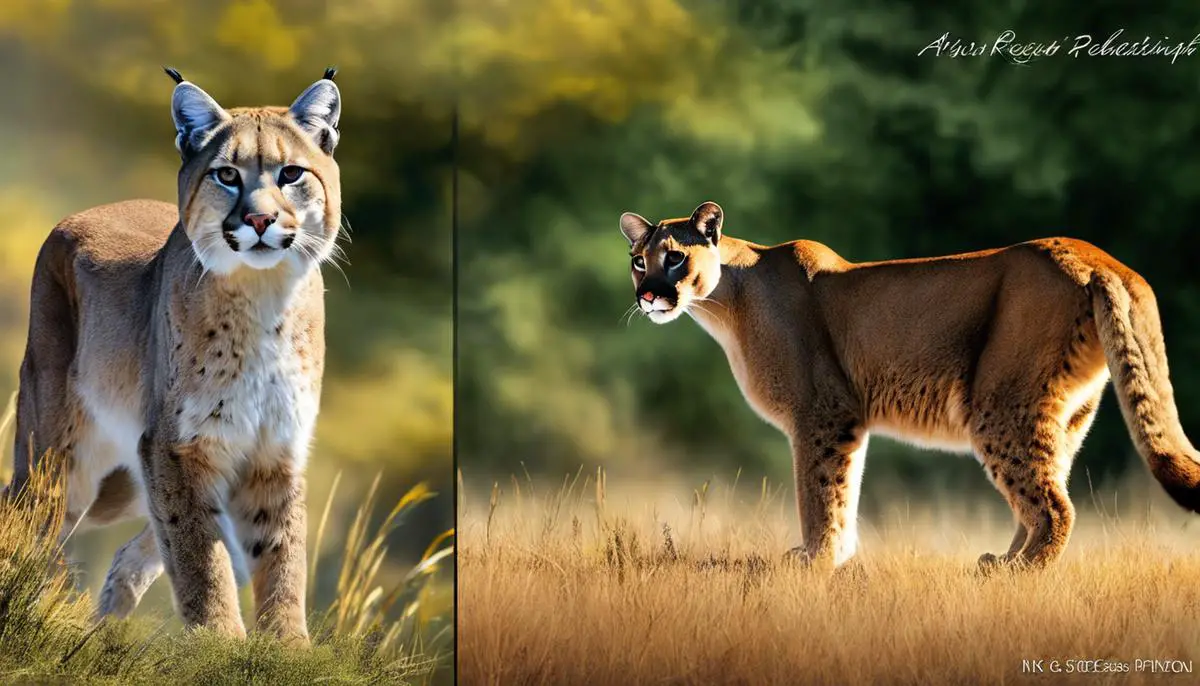Bobcat vs. Mountain Lion:🔍How to Tell the Difference!

Bobcats and mountain lions are two distinct species that are often confused with one another in the wild. This article aims to clarify the key differences between these two felines in terms of physical features, behaviors, and habitats. Understanding these distinctions is important for appreciating the diversity of wildlife in North America.
Physical Differences
Size and tail are the clearest indicators when distinguishing between a bobcat and a mountain lion. Bobcats weigh between 15 to 35 pounds, while mountain lions can range from 100 to 175 pounds.1 The bobcat has a short, roughly five-inch tail, whereas a mountain lion boasts a long, cylindrical tail, reaching 30 to 36 inches, often with a dark tip. These features are critical in confirming sightings.
Their appearances further set them apart. Bobcats exhibit an orangish coat with black spots, fitting for their smaller stature and diverse habitat preferences. Mountain lions wear a more uniform, tawny coat devoid of spots once they reach adulthood, blending into their mountainous or brush-filled terrains.2
These physical characteristics, along with differences in prey preference and behavior, separate these two species. Mountain lions mainly prey on deer, utilizing their powerful physique for the hunt, while bobcats hunt rabbits, birds, and other smaller animals. Each has adapted unique features and behaviors to thrive in their specific niches within North America’s ecosystems.

Common Misidentifications
In urban and suburban settings, the presence of bobcats and mountain lions often stirs up interest and concern among residents. Misidentification of these two distinct species is common, particularly along the urban-wildland interface where their territories may overlap. Citizens unfamiliar with the nuanced differences might categorize any large, tawny cat as a mountain lion, disregarding key biological and behavioral traits.
The growing popularity of home security systems and trail cameras has led to an increase in wildlife footage, bringing these elusive creatures into our digital viewfinders. The grainy, often monochromatic images captured under low light conditions make it challenging to accurately identify the subject.
The excitement of potentially spotting a mountain lion so close to human habitation may influence interpretations of these images. Hence, bobcats are often mistaken for their much larger cousins on the basis of insufficient evidence.3

Behavioral Signs
Behavioral differences can serve as a vital clue when distinguishing a bobcat from a mountain lion in the wild. Bobcats are more adaptable and may be spotted during the day, especially in human-altered landscapes where they hunt smaller prey.
They remain close to cover and demonstrate caution in open areas, reflecting their wariness of larger predators and humans. Bobcats can be seen using elevated points like rocks or fallen logs as vantage points, showcasing their preference for ambushing prey rather than chasing it over long distances.
Mountain lions exhibit distinct behaviors tied to their status as apex predators. These cats are primarily nocturnal, venturing out from dusk till dawn to stalk deer. Such large prey necessitates a solitary and stealthy lifestyle, with mountain lions covering extensive territories to avoid competition and find sufficient food.
Dragging a kill to a hidden location and covering it with debris to eat over several days is also telltale. While both species generally avoid humans, a mountain lion’s larger size and predatory nature may prompt it to defend a kill or its young if surprised or cornered, unlike the more reclusive bobcat.4

By understanding the physical characteristics, common misidentifications, and behavioral signs that set bobcats apart from mountain lions, we gain valuable knowledge about these species. This knowledge helps foster a greater appreciation for the complexity of nature and the roles these creatures play in their ecosystems.
Recognizing these differences is important for ensuring our coexistence with these animals is based on accurate information and respect for their habitats. As we continue to share spaces with them, staying informed about our wild neighbors is crucial.
- Sunquist M, Sunquist F. Wild Cats of the World. University of Chicago Press; 2002.
- Hansen K. Cougar: The American Lion. Mountain Lion Foundation; 1992.
- Alonso RS, McClure CJW, Lyren LM, Boydston EE, Crooks KR. Courtship behavior of bobcats and cougars: Differences between two felids with contrasting mating systems. Journal of Mammalogy. 2020;101(4):1158-1168.
- Logan KA, Sweanor LL. Desert Puma: Evolutionary Ecology and Conservation of an Enduring Carnivore. Island Press; 2001.
